Google Trends and Google Keyword Planner – tools of every marketer
Thanks to the guide „Practical use of SEO tools in your company” tips on how to use tools used every day in the SEO industry, you will learn the most important aspects of positioning. As many as 32 applications are described here, along with instructions for their use – this is a solid portion of knowledge that will prepare you for many tasks related to running SEO campaigns.
The book introduces you to the process step by step: from planning the campaign, through analyzing your own website from a technical point of view, to fixing errors and optimizing. It also contains issues concerning the analysis of competition in the organic results of the Google search engine and reporting the achieved results. You will learn how to find the most popular phrases typed by users into Google search engine and create better content thanks to them, as well as how to reach the sources of positioning links. You will also learn how to analyze information about users accessing your website.
Below we present Google Trends and Google Keyword Planner. This article is an excerpt from Paweł Cengiel’s book „Praktyczne zastosowanie narzędzi SEO w Twojej firmie”, which you can buy from the Helion publishing house.
Google Trends
The first tool I want to introduce you to is Google Trends, available at: https://trends.google.com. I use them for keyword analysis (more specifically, their popularity and seasonality), as well as for content development on my clients’ sites. The application allows you to analyze keywords based on anonymous data collected from the Google search engine, so you can access many keywords and related statistics. To start working with the application, first start by selecting the country, so that the data applies only to a specific area, for example. Polish.
Beneath the search engine, the Google Trends tool will tell you how to make the most of it. You will find a carousel with keywords and a selection of additional filters representing the capabilities of the application.
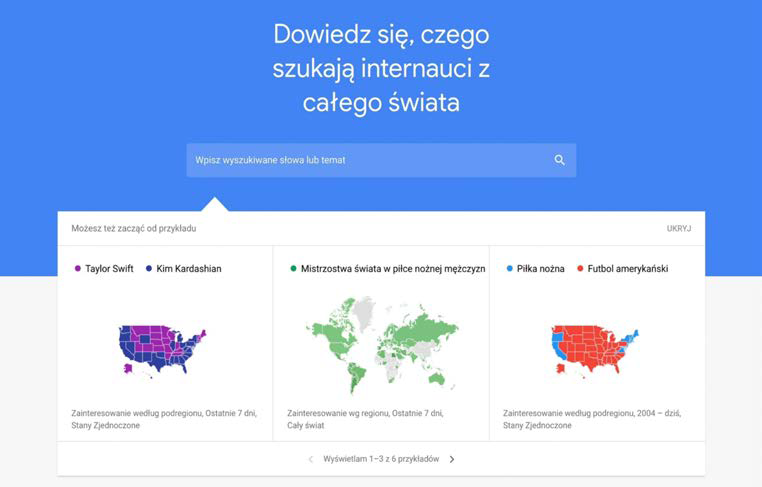 Google Trends tool homepage
Google Trends tool homepage
(source: trends.google.com)
 Selecting a search area (source: trends.google.com)
Selecting a search area (source: trends.google.com)
Below you will find the latest news and phrases that are gaining popularity in Google search. You can click on each of these to view related articles.
 Examples of usage of the tool (source: trends.google.com)
Examples of usage of the tool (source: trends.google.com)
 Phrases gaining popularity (source: trends).google.com)
Phrases gaining popularity (source: trends).google.com)
You can also check the Google search year summary and see the latest news on the development of the Google Trends tool. Enter any phrase to check its seasonality. Type it into the search engine and press the Enter key to see the results.
In the upper part of the search you will find the phrase indicated during the search. You can delete or edit it, as well as add another, similar phrase to compare them. Additionally, you can narrow or expand the search area to include other countries, set a specific period of time and indicate the category to which the entered phrase applies. Google Trends also allows you to choose the source of the data. This could be Google search, Google image search, news, shopping, or YouTube search (which is useful when optimizing video and channel names and descriptions on YouTube).
 Results for the entered phrase (source: trends.google.com)
Results for the entered phrase (source: trends.google.com)
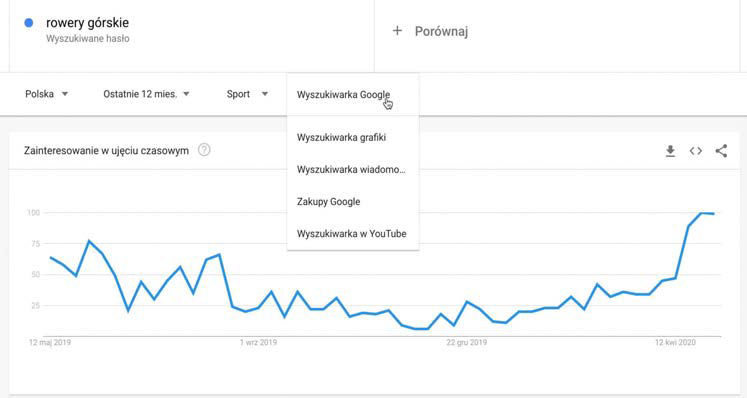 Additional filters in the search engine (source: trends.google.com)
Additional filters in the search engine (source: trends.google.com)
Below you will find the popularity chart by time and map by region. Pay attention to the division of the country and the colors applied to the individual provinces, which are responsible for the interest of users in the searched phrase. Use this feature if, for example. you are opening a stationary store and you are wondering in which region it would be most profitable. A darker color indicates the highest interest among Google search users. On the right you will find the same data, but in table form.
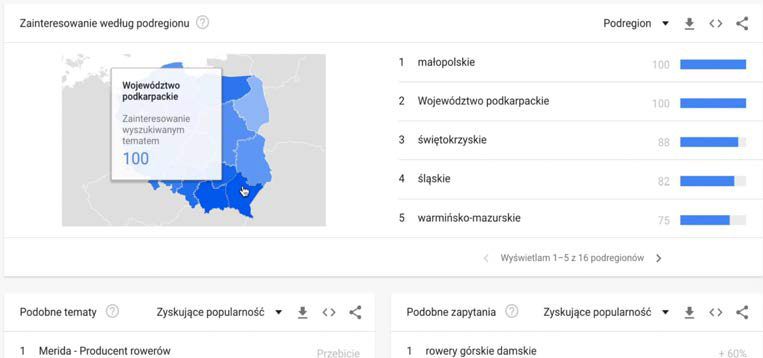 Interest in the topic among users with a breakdown of
Interest in the topic among users with a breakdown of
by regions (source: trends.google.com)
Next, Google Trends suggests related topics related to the phrase you entered, sorted by default by Gaining Popularity. Here you can find other equally popular queries in the Google search engine.
 Topics gaining popularity
Topics gaining popularity
(source: trends.google.com)
You can download the data from the table to a CSV file, place it on your website using the JavaScript code, and also share it with others, for example. on Facebook. In order to compare two phrases with each other, also enter a second suggestion and check which of them is more popular in Google search. Once you enter them, Google Trends will automatically assign them different colors so you can easily analyze the line graph and compare the popularity of phrases in Google search.
 Comparison of phrase popularity (source: trends).google.com)
Comparison of phrase popularity (source: trends).google.com)
Go to the following charts and check the interest in both phrases. Here you will find a map and a table that show comparative data about the phrases you have entered. If you run a stationary store, check which phrases are most searched in your region.
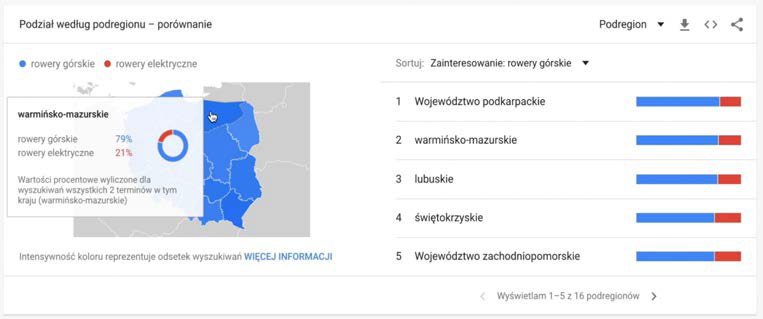 Comparison of phrase popularity in a given region
Comparison of phrase popularity in a given region
(source: trends.google.com)
Pay attention to the Similar queries section. You will find more phrases that are gaining popularity. Using these can translate into more traffic to your site coming from organic results. If you know that your keyword phrase can increase its popularity in Google from the middle of the year, it means that you should start publishing content as early as January (e.g. blog posts containing your keywords of interest) and acquire positioning links. Thanks to this, your website will be visible in response to a selected phrase in the period when it is most frequently searched.
Google Keyword Planner
The second Google tool I would like to tell you about is the Keyword Planner, available at: https://ads.google.com. As this service is closely related to the Google Ads system, I use it to find phrases for both advertising and SEO campaigns. To use this application, you must have an email account with Gmail, which will also allow you to log in to the Google Ads panel. After signing up for a Gmail account and logging into Google Ads, go to the Tools & Settings shortcut at the very top of the screen, and then in the Planning section, select Keyword Planner. You will see the Keyword Planner screen divided into two main sections.
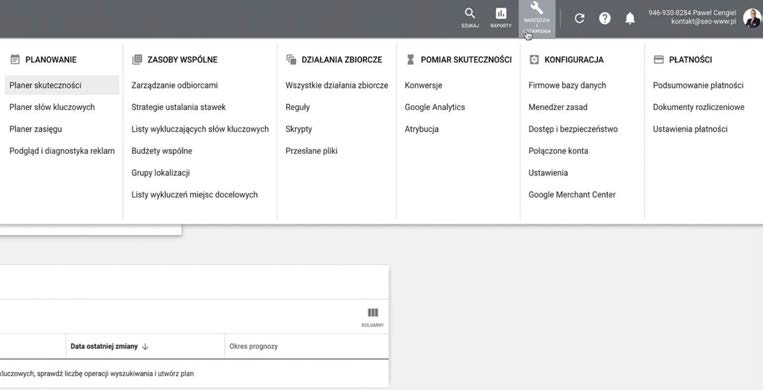 Keyword planner (source: ads.google.com)
Keyword planner (source: ads.google.com)
With the first section, Learn New Keywords, you can find the most popular phrases related to your business, products and services. If you don’t have a list of keywords, this section will work for you. The second is to find out the number of searches and predictions. Allows you to select additional keywords
to the ones you currently have. Here you can check the number of searches for phrases in the Google search engine, as well as the number of clicks on ads in the Google Ads system.
 Two functions for searching popular keywords
Two functions for searching popular keywords
(source: ads.google.com)
Go to the first section of Explore New Keywords to find new phrases for your SEO campaign. The keyword planner will ask you to provide details about the products or services you offer. Enter the URL of your online store or website below so that the planner can prepare phrase suggestions (taking data such as category names or product names from your online store). If you want to know suggestions for phrases thematically related to the one you are currently introducing, you don’t have to indicate any URL. Click the View Results button.
By default, the Keyword Planner uses the Polish localization and language, and the results are taken from the Google search engine. By default, you can see data from the previous 12 months. You can increase the search scope for your phrase, i.e. add more phrases to the list. The planner will also suggest you to add words that will expand the search results.
Next you will find trends related to the number of searches, presented as a column chart. Search results for a given phrase are divided into those from computers and those from smartphones.
Under the trends, the Keyword Planner shows suggestions for phrases related to the main phrase. You should use their list when linking, as well as in the content of subpages and blog articles. The first column contains the list of keywords, which has been sorted by relevance by default. The second one shows the average monthly number of searches for a given phrase (the average from the last 12 months). In the next column, the Keyword Planner evaluates the degree of competitiveness of a given phrase in relation to Google Ads. For your information, you can pay attention to the costs associated with a given phrase (the rates apply to ads in the Google Ads system) and check,
whether your budget will allow you to use a given phrase to create an ad in Google Ads.
 Searching for new keywords (source: ads.google.com)
Searching for new keywords (source: ads.google.com)
 Search volume trends for computers and smartphones
Search volume trends for computers and smartphones
(source: ads.google.com)
 Planner suggestions based on your main keyword
Planner suggestions based on your main keyword
(source: ads.google.com)
Pay attention to the possibility of narrowing the list of phrases – remove the less popular ones. To do this, go to the filters on the right side of the screen, expand them and see which categories you can opt out of. You can e.g. Hide or show those that don’t contain company names – that is, non-brands. After unchecking them, only phrases containing
brand name, and general phrases will be hidden.
After preparing the list of phrases you can generate them to a file in CSV format. Find the option Get keyword suggestions in the top right corner of the screen. A file with a set of phrases will be generated in the form of a clear table containing a list of keywords and additional data related to ads in the Google Ads system. Pay attention to the column with the average number of searches and with the degree of competition with values from 0 to 100. Phrases with a low number of searches are easier to position. If you haven’t positioned your website before, use phrases with a low number of searches to test your capabilities. Return to the main screen of the keyword planner to go to the second section – Know the number of searches and predictions. You can use it to check the popularity of your phrases (i.e. the number of their searches), as well as the competition in Google search. Enter some basic phrases to check their popularity in the search engine.
After getting the results, pay attention to the Forecasts tab, where you can find the forecast number of impressions and clicks for Google Ads.
 Narrowing down the results using filters (source: ads.google.com)
Narrowing down the results using filters (source: ads.google.com)
 A document containing a table with phrases (source: ads.google.com)
A document containing a table with phrases (source: ads.google.com)
This information will help you select the most popular phrases to use in your SEO campaign and in your website content. The planner also allows you to add new phrases – just click the blue icon with a plus sign.
 Forecast of impressions and clicks (source: ads.google.com)
Forecast of impressions and clicks (source: ads.google.com)
Similar to the Explore new keywords section, here you can also export a list of phrases to a file in CSV format.
Summary

You are interested in the topics? More can be found in the book. The set of advice and practical tips prepared by the author will help you effectively limit the most common mistakes resulting from improper website optimization, avoid penalties for techniques that do not comply with Google’s guidelines for webmasters and increase the number of user visits from the organic results.